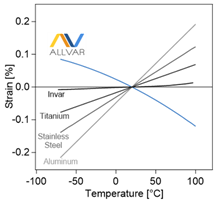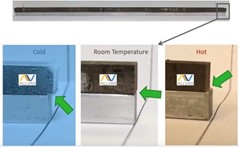The Defense Systems Information Analysis Center (DSIAC) received an inquiry asking if a metal with a negative coefficient of thermal expansion would be of interest for design of defense-related applications. A secondary question was also posed: what major U.S. government (USG) laboratory groups, contractors, academic institutions, and/or defense industry companies would likely benefit from a metal with a negative coefficient of thermal expansion? DSIAC compiled a list of relevant and recent DoD work efforts on this topic, as well as a list of potentially interested DoD groups, with the assistance of subject matter experts at Texas Research Institute Austin (TRI Austin).
1.0 Introduction
The inquirer requested information on the government’s need for metals with a negative coefficient of thermal expansion (NCTE) and how contractors conducting research on these metals could benefit from this need.
The Defense Systems Information Analysis Center (DSIAC) received support from subject matter experts (SMEs) from Texas Research Institute Austin (TRI Austin), Southwest Research Institute (SwRI), and the University of Texas at Austin (UT Austin). DSIAC and TRI completed a literature search using open sources and university libraries.
The literature search indicated that although every work mentions the importance of materials having an NCTE and mentions that there are many applications available for these materials, these works rarely provide detail about these applications. Also, the literature search revealed that although there is an increasing number of compounds that can produce an NCTE (i.e., they expand upon cooling and contract during heating, which is the opposite of the majority of other materials), the class of alloys known as ALLVAR is the only metal that exhibits true NCTE properties (Figure 1). However, recently, a computational study by Ho et al. suggests that gold nanowires may exhibit NCTE properties [1], which indicates that there may be similar discoveries in other metals in the future.


Figure 1: ALLVAR NCTE Properties (Top) and ALLVAR Expansion Compared to That of an Aluminum Alloy (Bottom) (Source: allvaralloys.com).
2.0 Potential NCTE Metal Applications
There are several areas where having an NCTE metal would be desirable (listed in no particular order):
- As a “thermal compensator” to tailor the coefficient of thermal expansion (CTE) of bulk materials such as either composites or metals. This concept could be applicable to dental fillings, which expand and contract depending on the temperature of food/drink being consumed, which can cause tooth pain [2].
- In decreasing thermal stresses due to CTE mismatches in items such as multilayer chip capacitors, solid oxide fuel cells, thermoelectric materials, and high-temperature piezoelectric materials.
- In precision optical equipment.
- In nano-devices.
- As a means for projectile/high-speed vehicle drag reduction or passive steering.
- In sealing applications [3].
- In components to provide dimensional stability throughout use in different and varied environments.
- Applications in electronics and electrolytics (batteries, capacitors, and resistors) catalysis, electrical energy storage/release, separation via tailorable voids, precision resistors, stresses on printed circuit boards, capacitor shrinkage, extending operating and stable temperature ranges of electronic components, avoiding mismatches with silicon-based components [4, 5].
- Fiber-optic coatings, such as in fiber Bragg gratings and for mirror substrates (options for mirrors include telescopes and mirrors used to steer laser light, such as in additive manufacturing machines).
- In decreasing mass in active and passive optics designs.
- Space-based applications such as spacecraft or satellite bus structures, deformable telescopes, and telescope steering.
- Actuators controlled by temperature changes [6].
- Ensuring reliability of the interface and to enhance the actuating ability of shape memory alloy hybrid composites [7, 8].
The potential advantages of an NCTE metal vs. a composite include the following:
- Fabrication conditions likely on the order of other titanium-based alloys (some NCTE materials require high fabrication pressures [>6 GPa] for synthesis) [9].
- Some of the NCTE filler materials used to tailor the bulk CTEs of composites are either pressure sensitive or autohydrate under ambient conditions [4].
3.0 Government-Contracted Industry, Academic, and Laboratory Groups That Might Benefit From This Technology
No official government needs statement was identified in this literature search regarding NCTE metals. However, due to the wide range of potential applications for NCTE metals, it is expected that government-contracted industry, academic, or laboratory groups would benefit from this technology.
References
[1] Ho, D. T., S Kwon, H. Park, and S. Y. Kim. “Negative Thermal Expansion of Ultrathin Metal Nanowires: A Computational Study.” Nano Letters, vol. 17, pp. 5113–5118, 2017.
[2] Lind, C. “Two Decades of Negative Thermal Expansion Research: Where Do We Stand?” Materials, vol. 5, pp. 1125–1154, 2012.
[3] Thieme, C., H. Gorls, and C. Russel. “Ba1-xSrxZn2Si2O7 – A New Family of Materials with Negative and Very High Thermal Expansion.” Scientific Reports, vol. 5, pp. 1–7, 2015.
[4] Miller, W., C. W. Smith, D. S. Mackenzie, and K. E. Evans. “Negative Thermal Expansion: A Review.” Journal of Materials Science, vol. 44, pp. 5441–5451, 2009.
[5] Stack Exchange. https://electronics.stackexchange.com/questions/143921/why-do-electronics-have-a-low-temperature-limit, accessed 18 November 2018.
[6] Lakes, R. “Cellular Solids with Tunable Positive or Negative Thermal Expansion of Unbounded Magnitude.” Applied Physics Letters, vol. 90, pp. 221905-1-3, 2007.
[7] Grima, J., V. Zammit, and R. Gatt. “Negative Thermal Expansion.” Journal of the Malta Chamber of Scientists, 2006.
[8] Zheng, Y. J., L. S. Cui, and J. Schrooten. “Effects of Additional Reinforcing Fibres on the Interface Quality of SMA Wire/Epoxy Composites.” PRICM 5: The 5th Pacific Rim International Conference on Advanced Materials and Processing, pp. 475–479, 2005.
[9] Takenaka, K. “Negative Thermal Expansion Materials: Technological Key for Control of Thermal Expansion.” Science and Technology of Advanced Materials, vol. 13, pp. 1–11, 2012.


